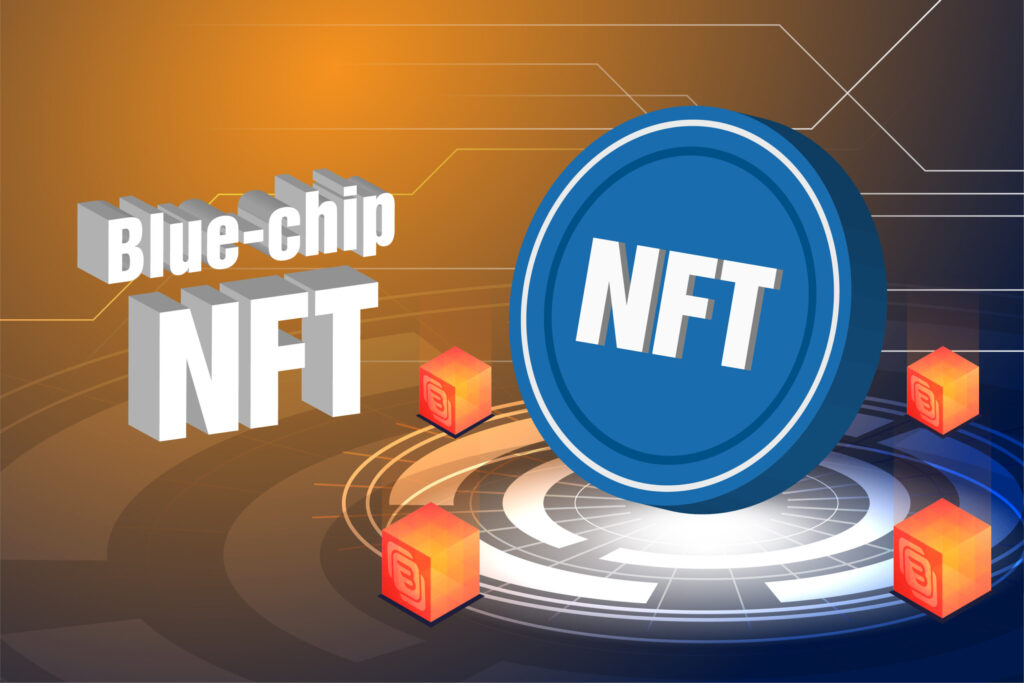The term “blue-chip” borrowed from the stock market is used to describe companies that are seen as solid investments with the ability to hold onto value and generate long-term returns for investors, such as Microsoft. Coca-cola, IBM, Samsung, and of course, Apile Blue-chip assets are considered reasonably safe investment options due to having a good operating history and, therefore, no likelihood of collapse or bankruptcy anytime soon
What is Blue-Chip NFTs?
Similarly, blue-chip nonfungible tokens are popular NFT projects that are expected to be stable and profitable and stable, especially long-term investment options in the manner of blockchain companies.
However, there is one key difference. Blue-chip assets often have a history of actively proving people’s imprints on them. Blue-chip NFT projects have no such track record. This comes as no surprise since both NET and blockchain technology are still fairly new.
What makes the “green-chip” NFTs?
The elements that make up a blue-chip NFT collection are neither definitive nor in question, but the following are common characteristics observed on most such blue-chip digital assets or digital art—high floor fakes, Good trading volume, celebrity or influencer endorsements as well as three key factors below
Popularity of the team or project creator
Most NT projects are still very new and do not yet have a track record of profitability that has been tested over time. So, investors enjoy the popularity of the brand behind the project. The larger and more well-known the team of brands who create NFTs, the more likely NFTs are to achieve green chip status. After all, those brands/celebrities have more influence and are more likely to already have a fan base.
For example, Veefriends is an NFT project created by Gary Vaynerchuk, a successful entrepreneur and public figure with a huge social media following. When Vaynerchuk launched its VeeFnonds collection in May 2021, it sold over $20 million in NFTs in a matter of weeks.
At the same time, not all popular NFT projects started as blue-chip options in the LIGHT space Measuring with some of these projects, creators rose to fame after launching their collections, Doodles and Cool Cats are two prominent examples
Similarly, just because an NFT project starts gaining popularity doesn’t mean it will achieve blue-chip status. Some projects may rely only on short-term hyperbole and will collapse after that hyperbolement wears off. Worse still, some pull the carpet altogether like the ice cream-themed Frosties project.
Take the roadmap
Most NFT projects will have a roadmap to let their community know where the project is located and the milestones it must meet along the way. Projects that can implement the plans in their roadmap are considered more grounded than those that cannot. In a word, the team’s ability to execute on the roadmap is an indication of the team creator’s commitment to delivering on what was promised. If the team behind the NFT has a track record of setting and meeting deadlines, investors and users alike will have more confidence in the project. The more faith a community has in a particular project, the more likely they are to invest in it.
The utility behind the NFT project
Some NFT projects have no function other than to become collector’s items. Many NFT projects rely on hype to appreciate the price, but without utility or community backing it, that hype can die off pretty quickly, dragging along with that project.
NFTs with real-world utility are those that have functions other than being collector’s items – for example, those that grant exclusive rewards or event access to the owner that notifies.
NFTs with powerful real-world utility put a lot of effort into building active, prosperous user communities. This highly engaged user base is both giving the NFT project sustained power beyond hype and elevating it to blue-chip status over time. Other NFT utilities include using a specific NFT in the game to complete a task.
Is investing in blue-chip NFTs safe?
Like any investment, buying blue-chip NFTs entails risk, including market volatility, the potential for fraudulent projects, and violations of intellectual property (IP) laws and regulations.
Even if blue-chip NFTs are typically thought to be more stable and attractive due to their scarcity and established market demand, NFT investments should be made cautiously. Market turbulence, the potential for price changes, and the possibility of fraudulent or subpar NFT projects are a few risks.
Blue-chip NFTs may involve digital assets that are based on copyrighted or trademarked material. If the NFTs make use of protected IP without getting permission, there is a chance of potential infringement. Legal repercussions, such as takedown requests or litigation, could follow and have an effect on the NFT’s worth and legality.
Moreover, since the legislative environment governing NFTs is underdeveloped, there may be ambiguities over how these digital assets will be handled and governed. To ensure adherence to current rules, such as securities legislation and Anti-Money Laundering regulations, one must stay up-to-date with the laws applicable in their jurisdiction.
Furthermore, because the NFT market is still developing, it is challenging to forecast the long-term performance of such assets. Some of these risks can be reduced by doing thorough research, diversifying your investments and keeping up with market movements.






